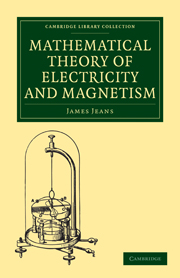Book contents
- Frontmatter
- Preface
- Contents
- Introduction
- ELECTROSTATICS AND CURRENT ELECTRICITY
- MAGNETISM
- ELECTROMAGNETISM
- CHAP. XIII The Magnetic Field Produced by Electric Currents
- CHAP. XIV Induction of Currents in Linear Circuits
- CHAP. XV Induction of Oueeents in Continuous Media
- CHAP. XVI Dynamical Theory of Currents
- CHAP. XVII Displacement Currents and Electromagnetic Waves
- CHAP. XVIII The Electromagnetic Theory of Light
- CHAP. XIX The Motion of Electrons
- CHAP. XX The Theory of Relativity
- CHAP. XXI The Electrical Structure of Matter
- INDEX
CHAP. XVI - Dynamical Theory of Currents
from ELECTROMAGNETISM
Published online by Cambridge University Press: 05 August 2011
- Frontmatter
- Preface
- Contents
- Introduction
- ELECTROSTATICS AND CURRENT ELECTRICITY
- MAGNETISM
- ELECTROMAGNETISM
- CHAP. XIII The Magnetic Field Produced by Electric Currents
- CHAP. XIV Induction of Currents in Linear Circuits
- CHAP. XV Induction of Oueeents in Continuous Media
- CHAP. XVI Dynamical Theory of Currents
- CHAP. XVII Displacement Currents and Electromagnetic Waves
- CHAP. XVIII The Electromagnetic Theory of Light
- CHAP. XIX The Motion of Electrons
- CHAP. XX The Theory of Relativity
- CHAP. XXI The Electrical Structure of Matter
- INDEX
Summary
GENERAL THEORY OF DYNAMICAL SYSTEMS.
We have so far developed the theory of electromagnetism by starting from a number of simple data which are furnished or confirmed by experiment, and examining the mathematical and physical consequences which can be deduced from these data.
There are always two directions in which it is possible for a theoretical science to proceed. It is possible to start from the simple experimental data and from these to deduce the theory of more complex phenomena. And it may also be possible to start from the experimental data and to analyse these into something still more simple and fundamental. We may, in fact, either advance from simple phenomena to complex, or we may pass backwards from simple phenomena to phenomena which are still simpler, in the sense of being more fundamental.
As an example of a theoretical science of which the development is almost entirely of the second kind may be mentioned the Dynamical Theory of Gases. The theory starts with certain simple experimental data, such as the existence of pressure in a gas, and the relation of this pressure to the temperature and density of a gas. And the theory is developed by shewing that these phenomena may be regarded as consequences of still more fundamental phenomena, namely the motion of the molecules of the gas.
- Type
- Chapter
- Information
- Mathematical Theory of Electricity and Magnetism , pp. 485 - 509Publisher: Cambridge University PressPrint publication year: 2009First published in: 1908

